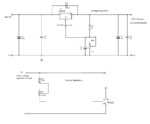plmrguest
Newbie level 3

I am trying to control voltage range from 1.5 to 34 using LM338 voltage regulator with 1000u capacitor at the input 430u capacitor at the output with potentiometer @ the adjustment terminal.
I have 37v and around 5 Amps current at the Vout but when i try to reduce the voltage using potentiometer,resistor 120 ohms burns out. Please suggest me how to control and get constant Voltage & Current.
I have 37v and around 5 Amps current at the Vout but when i try to reduce the voltage using potentiometer,resistor 120 ohms burns out. Please suggest me how to control and get constant Voltage & Current.





